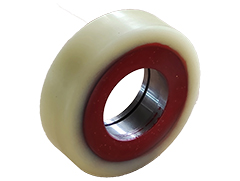What is the Difference Between Nylon Wheels and Polyurethane Wheels?
 Speaking of the difference between nylon wheels and polyurethane wheels,
we still mainly look at where and for what purpose.
Speaking of the difference between nylon wheels and polyurethane wheels,
we still mainly look at where and for what purpose.
Nylon wheel is an important branch product of abrasives, and it is an abrasive product after strong cutting abrasive products such as abrasive belt wheels. Nylon wheel products are mainly composed of nylon fiber mesh, grinding media (ore), bonding resin and other main components, and various additives such as heat absorption additives, fillers, and pigments may be added. The English name of nylon is Polyamide, which is the general name for polymers containing amide groups in the repeating units of the main chain of macromolecules. Polyamides can be prepared by ring-opening polymerization of internal acid amines, and can also be obtained by polycondensation of diamines and dibasic acids.
Polyurethane is made by polymerizing isocyanate (monomer) and hydroxyl compound. Because it contains strong polar urethane groups, it is insoluble in non-polar groups, and has good oil resistance, toughness, abrasion resistance, aging resistance and adhesion. Different raw materials can be used to produce materials suitable for a wide temperature range (-50~150℃), including elastomers, thermoplastic resins and thermosetting resins. It is not resistant to hydrolysis at high temperatures, nor is it resistant to alkaline media.
Therefore, the wheel hardness of nylon materials is generally higher and more wear-resistant. It is better in terms of load-bearing. Polyurethane wheels are softer, and have relatively weaker strength than nylon wheels, but the noise reduction effect is much better and the overall ability is higher. Of course, nylon is also soft, and polyurethane has high hardness, and sometimes the hardness of the two can be similar. In short, it depends on the specific situation, and choosing the most suitable is the best choice.










